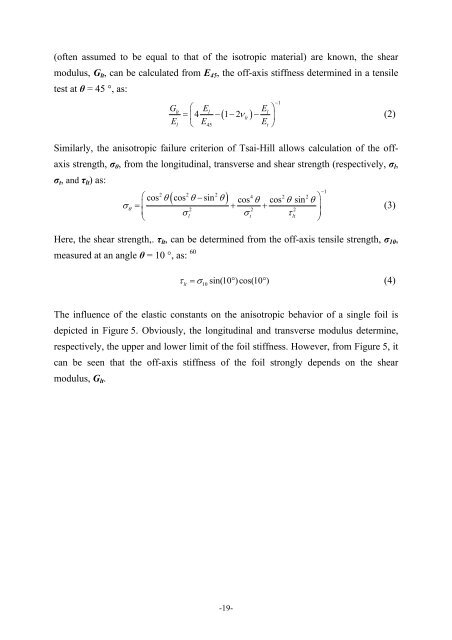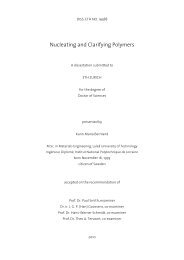ABFIGURE 4 A. Schematic of a planar oriented aggregate of crystalline entities, as often found inbiaxially deformed films. B. Structure of a planar assembly of perfect, extended-chain polymercrystals. 432.1 Classical Lamination TheoryUniaxially oriented polymer foils, such as drawn tapes or even single-crystal layers,can typically be regarded as transversely isotropic materials, characterized by fiveindependent elastic constants, having a high stiffness in the longitudinal direction anda low isotropic modulus in the plane transverse to the longitudinal direction. The offaxisstiffness and strength of laminates from these foils is then described, respectively,by classical lamination theory, and anisotropic failure rules, such as the Tsai-Hillcriterion. 59In classical lamination theory, it is assumed that a laminate is in a plane stress state,reducing the number of relevant elastic constants for a single foil to four: thelongitudinal modulus, E l , the transverse modulus, E t , the shear modulus, G lt , and thePoisson’s ratio, υ lt . It can be shown through an appropriate coordinate transformationof the compliance tensor, that in uniaxial deformation, the off-axis Young’s modulus,E θ , of a single foil varies with θ, the angle between the loading direction and thelongitudinal axis as:E ⎛4⎛ E ⎞l2 2 E ⎞θ l 4= cos θ 2νltcos θsin θ sin θE ⎜+ ⎜ − ⎟+lGlt E ⎟⎝ ⎝ ⎠t ⎠−1(1)When the longitudinal and transverse modulus, E l and E t , and the Poisson’s ratio υ lt-18-
(often assumed to be equal to that of the isotropic material) are known, the shearmodulus, G lt , can be calculated from E 45 , the off-axis stiffness determined in a tensiletest at θ = 45 °, as:G ⎛ltEl E ⎞l= ⎜4 −( 1−2νlt ) − ⎟El⎝ E45Et⎠−1(2)Similarly, the anisotropic failure criterion of Tsai-Hill allows calculation of the offaxisstrength, σ θ , from the longitudinal, transverse and shear strength (respectively, σ l ,σ t , and τ lt ) as:( − )2 2 2⎛cos θ cos θ sin θ 4 2 2cos θ cos θ sin θ ⎞σθ= + +2 2 2⎜ σl σt τ ⎟⎝lt⎠Here, the shear strength,. τ lt , can be determined from the off-axis tensile strength, σ 10 ,−1(3)measured at an angle θ = 10 °, as: 60 10τlt= σ sin(10 ° )cos(10 ° )(4)The influence of the elastic constants on the anisotropic behavior of a single foil isdepicted in Figure 5. Obviously, the longitudinal and transverse modulus determine,respectively, the upper and lower limit of the foil stiffness. However, from Figure 5, itcan be seen that the off-axis stiffness of the foil strongly depends on the shearmodulus, G lt .-19-
- Page 3: Diss. ETH No. 17603Ultra-high-perfo
- Page 7: «I do not propose to say much abou
- Page 10 and 11: Ultra-high-performance unidirection
- Page 12 and 13: Hauptketten wirken bei den Aramidfa
- Page 14 and 15: Planare HochleistungsfolienWie bere
- Page 16 and 17: Feuilles de polymères hautes-perfo
- Page 19 and 20: 1 BackgroundThe use of polymers in
- Page 21 and 22: A third process for the production
- Page 23 and 24: 2 From Fiber to Fabric and Film and
- Page 25: iaxially oriented polymer films. Su
- Page 29 and 30: expressed as: 61 21 1 El( El + Et
- Page 31 and 32: The properties of such laminated st
- Page 33 and 34: 5 References and Notes1. Carothers,
- Page 35: 68. The Composite Materials Handboo
- Page 39 and 40: 1 IntroductionIt has long been reco
- Page 41 and 42: - unlike the present work - focused
- Page 43 and 44: allowed to evaporate under air flow
- Page 45 and 46: Dynamical mechanical thermal analys
- Page 47 and 48: solid-state compressed films of vir
- Page 49 and 50: Following pseudo-affine orientation
- Page 51 and 52: shown E-λ plots for foils with dif
- Page 53 and 54: 55A B C5444333σ D (MPa)2σ D(MPa)2
- Page 55 and 56: esulting thermograms are presented
- Page 57 and 58: A100 μmλ = 510 2030 40 5070 90 10
- Page 59 and 60: A B CD E1 cmFσ (MPa)45403530252015
- Page 61 and 62: polymer foils is determined princip
- Page 63 and 64: AdhesionIn order to promote adhesio
- Page 65 and 66: FIGURE 14 Scanning electron microgr
- Page 67 and 68: foil is shown in Figure 15B, and fo
- Page 69 and 70: Small deviations from quasi-isotrop
- Page 71: 56. Smith, P. ; Lemstra, P. J. J. M
- Page 75 and 76: 1 IntroductionIn this chapter, effo
- Page 77 and 78:
TABLE 1 Young’s modulus, E, and t
- Page 79 and 80:
s12A-A0.50.1B-B17BAABs2BA13A-A0.1B-
- Page 81 and 82:
ABextruder20 mmFIGURE 4 A. Schemati
- Page 83 and 84:
and planar foils were tested in ten
- Page 85 and 86:
s11 3 10 33 120s2504540353013 1729
- Page 87 and 88:
f1-s11 2 4 913f2-s2A6560555045401 3
- Page 89 and 90:
4.4 Air-gap ExtrusionIn view of the
- Page 91 and 92:
A100B1001010W ratio / T ratio (-)10
- Page 93 and 94:
ABCDFIGURE 11 A. Photographs of as-
- Page 95 and 96:
A70B1.2601.0500.8E (GPa)40302010σ
- Page 97 and 98:
Finally, the mechanical characteris
- Page 99:
6 References and Notes1. Kwolek, S.
- Page 103 and 104:
1 IntroductionIt was already discus
- Page 105 and 106:
2 ExperimentalMaterials. The polyme
- Page 107 and 108:
3 Results and Discussion3.1 Foil Ex
- Page 109 and 110:
3.2 Heat TreatmentAs already demons
- Page 111 and 112:
Expectedly, the Young’s modulus o
- Page 113 and 114:
the experimentally observed angular
- Page 115:
5 References1. Aoki, H. ; Onogi, Y.
- Page 119 and 120:
1 IntroductionCellulose is the main
- Page 121 and 122:
2 ExperimentalMaterials. The nutrie
- Page 123 and 124:
A0.5 mmBCFIGURE 1 Bacterial cellulo
- Page 125 and 126:
Finally, the test-angle dependence
- Page 127:
5 References1. Meyer, K. H. ; Lotma
- Page 131 and 132:
1 ConclusionsThe results presented
- Page 133 and 134:
10,0001,000σ (MPa/(g/cm 3 ))100101
- Page 135 and 136:
1.4 Final ConclusionIn the literatu
- Page 137 and 138:
precursor fibers, which, however, a
- Page 139:
3 References1. Gordon, J. E. Proc.
- Page 142 and 143:
Group for great unforgettable teamw




